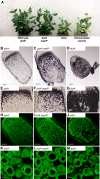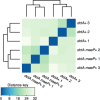Succinate Transport Is Not Essential for Symbiotic Nitrogen Fixation by Sinorhizobium meliloti or Rhizobium leguminosarum
- PMID: 28916561
- PMCID: PMC5734035
- DOI: 10.1128/AEM.01561-17
Succinate Transport Is Not Essential for Symbiotic Nitrogen Fixation by Sinorhizobium meliloti or Rhizobium leguminosarum
Abstract
Symbiotic nitrogen fixation (SNF) is an energetically expensive process performed by bacteria during endosymbiotic relationships with plants. The bacteria require the plant to provide a carbon source for the generation of reductant to power SNF. While C4-dicarboxylates (succinate, fumarate, and malate) appear to be the primary, if not sole, carbon source provided to the bacteria, the contribution of each C4-dicarboxylate is not known. We address this issue using genetic and systems-level analyses. Expression of a malate-specific transporter (MaeP) in Sinorhizobium meliloti Rm1021 dct mutants unable to transport C4-dicarboxylates resulted in malate import rates of up to 30% that of the wild type. This was sufficient to support SNF with Medicago sativa, with acetylene reduction rates of up to 50% those of plants inoculated with wild-type S. melilotiRhizobium leguminosarum bv. viciae 3841 dct mutants unable to transport C4-dicarboxylates but expressing the maeP transporter had strong symbiotic properties, with Pisum sativum plants inoculated with these strains appearing similar to plants inoculated with wild-type R. leguminosarum This was despite malate transport rates by the mutant bacteroids being 10% those of the wild type. An RNA-sequencing analysis of the combined P. sativum-R. leguminosarum nodule transcriptome was performed to identify systems-level adaptations in response to the inability of the bacteria to import succinate or fumarate. Few transcriptional changes, with no obvious pattern, were detected. Overall, these data illustrated that succinate and fumarate are not essential for SNF and that, at least in specific symbioses, l-malate is likely the primary C4-dicarboxylate provided to the bacterium.IMPORTANCE Symbiotic nitrogen fixation (SNF) is an economically and ecologically important biological process that allows plants to grow in nitrogen-poor soils without the need to apply nitrogen-based fertilizers. Much research has been dedicated to this topic to understand this process and to eventually manipulate it for agricultural gains. The work presented in this article provides new insights into the metabolic integration of the plant and bacterial partners. It is shown that malate is the only carbon source that needs to be available to the bacterium to support SNF and that, at least in some symbioses, malate, and not other C4-dicarboxylates, is likely the primary carbon provided to the bacterium. This work extends our knowledge of the minimal metabolic capabilities the bacterium requires to successfully perform SNF and may be useful in further studies aiming to optimize this process through synthetic biology approaches. The work describes an engineering approach to investigate a metabolic process that occurs between a eukaryotic host and its prokaryotic endosymbiont.
Keywords: Sinorhizobium; cross-kingdom interactions; dicarboxylate; endosymbionts; malic acid; metabolic engineering; metabolism; nitrogen fixation; nutrient transport; transcriptome.
Copyright © 2017 American Society for Microbiology.
Figures




Similar articles
-
Sinorhizobium medicae WSM419 Genes That Improve Symbiosis between Sinorhizobium meliloti Rm1021 and Medicago truncatula Jemalong A17 and in Other Symbiosis Systems.Appl Environ Microbiol. 2021 Jul 13;87(15):e0300420. doi: 10.1128/AEM.03004-20. Epub 2021 Jul 13. Appl Environ Microbiol. 2021. PMID: 33990306 Free PMC article.
-
Role of symbiotic auxotrophy in the Rhizobium-legume symbioses.PLoS One. 2010 Nov 11;5(11):e13933. doi: 10.1371/journal.pone.0013933. PLoS One. 2010. PMID: 21085630 Free PMC article.
-
Role of O2 in the Growth of Rhizobium leguminosarum bv. viciae 3841 on Glucose and Succinate.J Bacteriol. 2016 Dec 13;199(1):e00572-16. doi: 10.1128/JB.00572-16. Print 2017 Jan 1. J Bacteriol. 2016. PMID: 27795326 Free PMC article.
-
What determines symbiotic nitrogen fixation efficiency in rhizobium: recent insights into Rhizobium leguminosarum.Arch Microbiol. 2023 Aug 5;205(9):300. doi: 10.1007/s00203-023-03640-7. Arch Microbiol. 2023. PMID: 37542687 Review.
-
C4-dicarboxylate carriers and sensors in bacteria.Biochim Biophys Acta. 2002 Jan 17;1553(1-2):39-56. doi: 10.1016/s0005-2728(01)00233-x. Biochim Biophys Acta. 2002. PMID: 11803016 Review.
Cited by
-
Understanding transport processes in lichen, Azolla-cyanobacteria, ectomycorrhiza, endomycorrhiza, and rhizobia-legume symbiotic interactions.F1000Res. 2020 Jan 23;9:F1000 Faculty Rev-39. doi: 10.12688/f1000research.19740.1. eCollection 2020. F1000Res. 2020. PMID: 32047609 Free PMC article. Review.
-
Sinorhizobium medicae WSM419 Genes That Improve Symbiosis between Sinorhizobium meliloti Rm1021 and Medicago truncatula Jemalong A17 and in Other Symbiosis Systems.Appl Environ Microbiol. 2021 Jul 13;87(15):e0300420. doi: 10.1128/AEM.03004-20. Epub 2021 Jul 13. Appl Environ Microbiol. 2021. PMID: 33990306 Free PMC article.
-
Exo-Metabolites of Phaseolus vulgaris-Nodulating Rhizobial Strains.Metabolites. 2019 May 30;9(6):105. doi: 10.3390/metabo9060105. Metabolites. 2019. PMID: 31151153 Free PMC article.
-
Metabolic control of nitrogen fixation in rhizobium-legume symbioses.Sci Adv. 2021 Jul 30;7(31):eabh2433. doi: 10.1126/sciadv.abh2433. Print 2021 Jul. Sci Adv. 2021. PMID: 34330708 Free PMC article.
-
Regulation of Rhizobial Nodulation Genes by Flavonoid-Independent NodD Supports Nitrogen-Fixing Symbioses With Legumes.Environ Microbiol. 2025 Jan;27(1):e70014. doi: 10.1111/1462-2920.70014. Environ Microbiol. 2025. PMID: 39865396 Free PMC article.
References
-
- Schulze J, Shi L, Blumenthal J, Samac DA, Gantt JS, Vance CP. 1998. Inhibition of alfalfa root nodule phosphoenolpyruvate carboxylase through an antisense strategy impacts nitrogen fixation and plant growth. Phytochemistry 49:341–346. doi:10.1016/S0031-9422(98)00221-0. - DOI
MeSH terms
Substances
LinkOut - more resources
Full Text Sources
Other Literature Sources
Molecular Biology Databases

